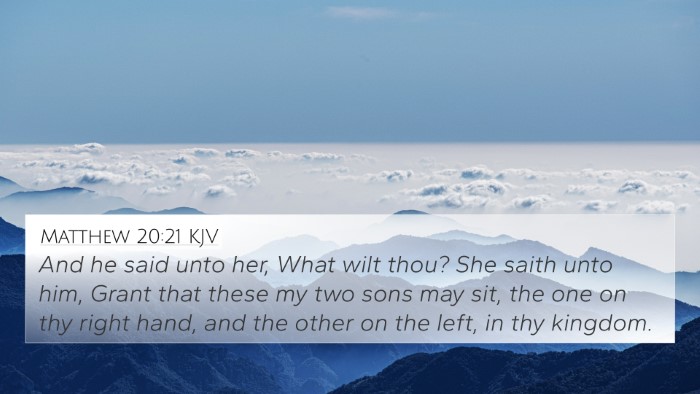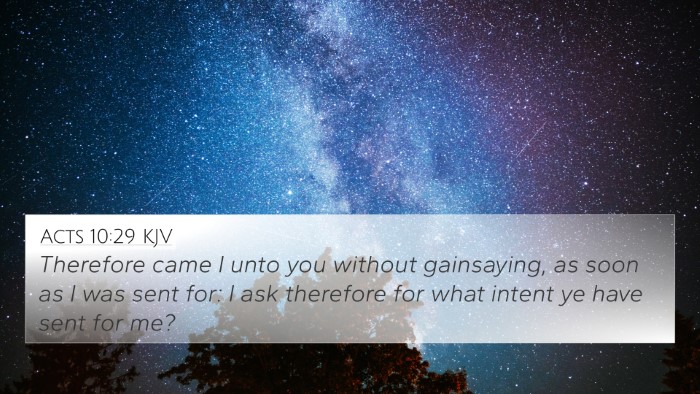Understanding Matthew 20:32
Matthew 20:32 states:
"And Jesus stood still, and called them, and said, What will ye that I shall do unto you?"
This verse is deeply significant as it illustrates the compassion and attentiveness of Jesus towards those in need. Let's explore its meaning, connections to other scriptures, and insights from various public domain commentaries, along with cross-references for comprehensive understanding.
Contextual Background
In this passage, Jesus encounters two blind men who cry out to Him for mercy as He passes by Jericho. Their faith and determination to reach out to Him highlight a critical theme in the Gospels: Jesus' approachability and His readiness to heal and restore.
Commentary Insights
-
Matthew Henry:
Henry emphasizes the importance of the blind men’s faith. Their persistence in calling upon Jesus reflects a broader truth: in periods of desperation, faith becomes an avenue through which divine intervention manifests. Jesus’ response is not merely a physical act of healing; it illustrates His willingness to engage with those who earnestly seek Him.
-
Albert Barnes:
Barnes remarks on the phrase “What will ye that I shall do unto you?” as a potent reminder that Jesus not only heals but does so in accordance with the desires of those He aids. This interactive approach emphasizes the importance of personal desire in the journey of faith; it highlights a relationship dynamic where believers are encouraged to voice their needs.
-
Adam Clarke:
Clarke explores the context of this miracle within Jesus' ministry, noting that it demonstrates His authority and kindness. Clarke concludes that this incident foreshadows the greater spiritual blindness many exhibit and underscores the necessity of recognizing our need for healing—both physically and spiritually.
Thematic Connections
This verse creates multiple thematic connections within the Bible:
-
Compassion: Similar to Jesus' interaction with the blind men, the theme of compassion is central throughout scripture, as seen in Matthew 14:14, where Jesus heals the sick out of compassion.
-
Faith: The faith of the blind men in this verse parallels the faith seen in Hebrews 11:1, where the essence of faith is defined. Their belief in Jesus' ability to heal is a cornerstone for understanding faith in action.
-
Desperation for Divine Help: This moment echoes the cries in Psalms 34:6, showcasing that those who are afflicted can call out to God and find salvation in their distress.
-
Divine Authority: In Matthew 8:8-13, the centurion expresses faith that Jesus can heal from afar, establishing a pattern of recognizing Jesus’ divine authority over health and wellbeing.
-
Personal Relationship with Christ: The interaction between Jesus and the blind men reflects the call for a personal relationship depicted in John 10:3-4, where the sheep know the voice of their Shepherd.
-
Healing as a Sign of Salvation: In Luke 18:42, Jesus’ healing of a blind man is coupled with the declaration of his faith leading to salvation, showcasing healing as a spiritual metaphor.
-
Persistence in Prayer: The dialogue emphasizes the importance of persistence in seeking God, akin to the parable in Luke 18:1-8 regarding the persistent widow.
-
Accessibility of Jesus: The fact that Jesus halted for these men signifies His readiness to listen to those marginalized, akin to the welcome seen in Mark 10:14 where Jesus rebukes those who would prevent children from coming to Him.
Cross-References
Here are several cross-references that relate to Matthew 20:32:
- Matthew 9:27-30 - Another account of blind men healed by Jesus.
- Mark 10:46-52 - The healing of Bartimaeus, illustrating Jesus’ compassion.
- Luke 18:35-43 - Similar healing with an emphasis on faith.
- Acts 3:1-10 - The healing of a lame man that echoes this compassionate healing narrative.
- Isaiah 35:5-6 - Prophecy about the coming of the Lord who would heal the blind.
- John 9:1-7 - Jesus heals a blind man; demonstrating His divine power and authority.
- Romans 10:14 - The importance of calling upon the Lord in faith.
- 2 Corinthians 5:7 - Living by faith, not by sight, ties in with the blind men’s experience.
Conclusion
Matthew 20:32 is rich with meaning regarding faith, compassion, and the nature of Christ's ministry. Understanding this verse within its broader biblical context enhances our appreciation of its significance. Through cross-referencing and thematic exploration, we can see not only its individual message but also its place within the tapestry of Scripture.
Tools for Cross-Referencing
For those studying the Bible deeply, utilizing tools such as a Bible concordance or a Bible cross-reference guide can provide invaluable insights. These resources enable cross-referencing Bible study methods, enhancing comprehension of scriptural connections.
Further Study
For a more detailed analysis of related verses, consider exploring:
- Bible verses related to spiritual blindness.
- Identifying connections between Old and New Testament teachings on healing.
- Comparative study of Jesus’ healing miracles across the Gospels.
- Discussion on the relationships between the teachings of the Prophets and the Apostolic messages.
- Paths toward understanding how Biblical themes interlink through cross-references.






